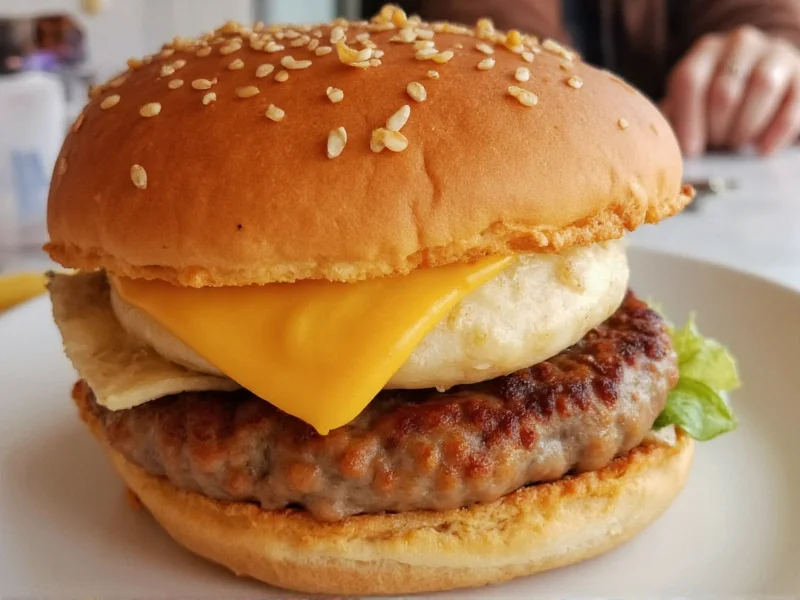The Origins of McDonald's Sausage McMuffin
McDonald's introduced the sausage mcmuffin in 1971 as part of its expanding breakfast menu. Created by Herb Peterson in Santa Barbara, California, the sandwich was designed to offer customers a hot, portable breakfast option that could be eaten with one hand. The sausage mcmuffin quickly gained popularity, becoming one of McDonald's most enduring breakfast items. Unlike many fast food innovations that come and go, this pork sausage breakfast sandwich has maintained consistent demand for over 50 years.
Standard Ingredients and Preparation
The classic sausage mcmuffin consists of three simple components: a 2.3-ounce seasoned pork sausage patty, a toasted English muffin, and nothing else. McDonald's prepares the sausage patty on a flat-top grill, then places it on the bottom half of a split and toasted English muffin. The sandwich contains no cheese or additional toppings in its basic form, though many customers customize their order.
Nutritional Profile of the Sausage McMuffin
Understanding the nutritional content helps consumers make informed choices about this popular breakfast option. The standard sausage mcmuffin nutrition facts provide essential information for those monitoring their dietary intake.
| Nutrient | Amount | % Daily Value* |
|---|---|---|
| Calories | 400 | 20% |
| Total Fat | 26g | 34% |
| Saturated Fat | 10g | 50% |
| Cholesterol | 95mg | 32% |
| Sodium | 880mg | 38% |
| Total Carbohydrates | 29g | 11% |
| Protein | 15g | - |
*Percent Daily Values are based on a 2,000 calorie diet. Individual values may vary.
How Sausage McMuffin Compares to Similar Breakfast Sandwiches
When evaluating breakfast sandwich options, the sausage mcmuffin stands apart from competitors in several ways. Unlike biscuit-based sandwiches, the English muffin provides a distinctive texture that absorbs sausage juices without becoming soggy. Compared to the sausage egg mcmuffin, the standard version offers a simpler flavor profile focused on the seasoned pork sausage and toasted muffin.
Breakfast enthusiasts often debate the merits of sausage mcmuffin vs sausage biscuit. The English muffin's nooks and crannies create a different eating experience than the flaky, buttery texture of a biscuit. The mcmuffin generally contains fewer calories than comparable biscuit sandwiches while delivering similar protein content.
Creating a Homemade Sausage McMuffin
Many home cooks seek to replicate the mcdonald's sausage mcmuffin experience. While exact recipes are proprietary, you can create a satisfying homemade sausage mcmuffin recipe with these steps:
- Split and toast an English muffin until golden brown
- Cook a 2.5-ounce pork sausage patty (seasoned with salt, pepper, and sage) on medium heat for 4-5 minutes per side
- Place the cooked sausage patty on the bottom muffin half
- Add the top muffin half and serve immediately
For best results when making a homemade sausage mcmuffin, use quality pork sausage with a fat content around 20%. The sausage should be formed into patties slightly larger than the English muffin, as it will shrink during cooking. Many home versions include cheese or egg for added flavor, though these aren't part of the original mcdonald's sausage mcmuffin calories standard.
Regional Variations and Limited-Time Offerings
While the basic sausage mcmuffin remains consistent, McDonald's has introduced regional variations. In some international markets, you might find sausage mcmuffin options with different seasonings or bread alternatives. The core product, however, maintains its signature combination of seasoned pork sausage and toasted English muffin that customers have come to expect.
Frequently Asked Questions
What's the difference between a sausage mcmuffin and a sausage egg mcmuffin?
The primary difference is that the sausage egg mcmuffin includes a folded egg patty in addition to the sausage and English muffin. The standard sausage mcmuffin contains only the sausage patty and English muffin with no additional ingredients.
Does McDonald's sausage mcmuffin contain dairy?
The standard sausage mcmuffin does not contain dairy ingredients. However, if ordered with cheese or as part of a combo meal with milk products, dairy would be present. Always check current ingredient information if you have dietary restrictions.
How can I reduce the calorie count of a sausage mcmuffin?
To create a lower-calorie version, use leaner pork sausage (reducing fat content from 26g to approximately 15g), or consider using turkey sausage instead of traditional pork sausage while maintaining the English muffin base.
Why is it called a mcmuffin rather than just a sausage muffin?
The "Mc" prefix is McDonald's branding convention for many menu items, signifying it's a McDonald's creation. The name distinguishes it from generic sausage muffins and establishes it as part of McDonald's proprietary product line.











 浙公网安备
33010002000092号
浙公网安备
33010002000092号 浙B2-20120091-4
浙B2-20120091-4